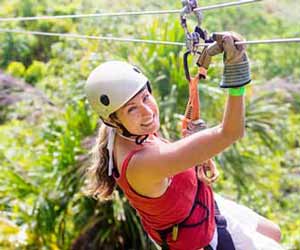Zip Line Guide
Have you ever experienced the adrenaline rush of flying through the air on a zip line? People love it. That’s why zip lines are popping up all over the place. All of those zip lines need safety conscious zip line guides to take guests on high-flying zip line adventures.
Zip lining is an outdoor adventure activity. Basically, a zip line connects two points with a steel cable.People attach themselves to the cable with a harness and pulley so they can go for a ride. Usually, a series of zip lines will cruise through a mountain environment, brush the top of the rainforest, or zoom over eager on-looker’s heads.
Zip lining is popular with people of all ages. It requires a minimal amount of physical exertion for an exceptional adrenaline rush that thrill seekers love. Some people are zip line enthusiasts, while others zip line to tick something off their bucket list.

Zip lines are being build all over the world to entertain thousands of people every year. They are located everywhere – Alaska, Washington, British Columbia, Montana, Colorado, Florida, Peru, Nepal, China, Costa Rica, Honduras, and Brazil for example. Almost every state has at least one zip line operation. They are popular attractions that operate rain or shine all year long. There is probably a zip line guide job near you.
Every zip line is different. The design, build, and location will dictate the number of zips, the speed, the length, and the height. The world’s longest zip is called The Eye of the Jaguar. It travels 2,130 meters and is located in Cusco, Peru. One zip line in Nepal sends guests at record breaking speeds of 75 miles per hour. You can imagine how thrilling those zips must be.
Zip line guides help to operate these zip lines. It’s the zip line guide’s responsibility to make sure that guests safely navigate the zip line course in a safe and efficient manner. Most zip line guides need no formal education and often these are entry-level positions. Zip line guides typically work at amusement parks, adventure parks, or ski resorts. Employers look for guest service experience and safety oriented people to fill these roles. Sometimes experience operating ropes courses or climbing walls is a resume bonus. Overall, zip lining is a loosely regulated industry. That’s why a safety conscious zip line guide is essential for every operation.
A day in the life of a zip line guide is a blast. Zip line guides work in teams. During the daily safety inspection they inspect cables, adjust ladders, tweak braking systems, and check harnesses. Next, zip line guides meet guests and equip them with body harnesses, attachment systems, pulleys, and helmets. They give a brief safety presentation before they walk or catch a ride to the top. Finally, it’s time to zip.
Zip line guides show guest how to clip in, watch to make sure guests don’t get a finger or a ponytail lodged in the system, help guests put on the brakes, and help them transition from one zip line to the next. Zip line guides may do this multiple times throughout the day.
It sounds pretty fun, right? Often zip line jobs are seasonal, but some businesses operate year round. If you really love zip lining, there are also jobs for people who travel the country designing and building zip lines. Zip line guides usually make around $10 per hour plus tips.
If you like the thrill of flying through the air on a zip line, why not get paid to take people on zip line adventures?
Quick Facts About Zip Line Guides
Job Title: Zip Line Guide, Zip Line Operator
Office: Zip line course
Description: Ensure guest safety on a high-flying zip line adventures
Certifications/Education: None
Necessary Skills: Guest service, safety conscious
Potential Employers: Ski areas, Zip line operations, Amusement parks
Pay: $10 per hour plus tips

